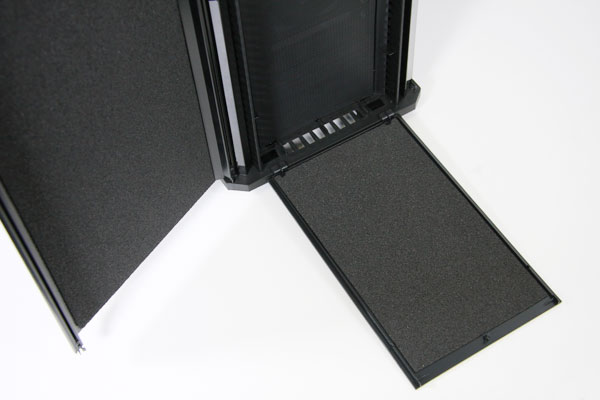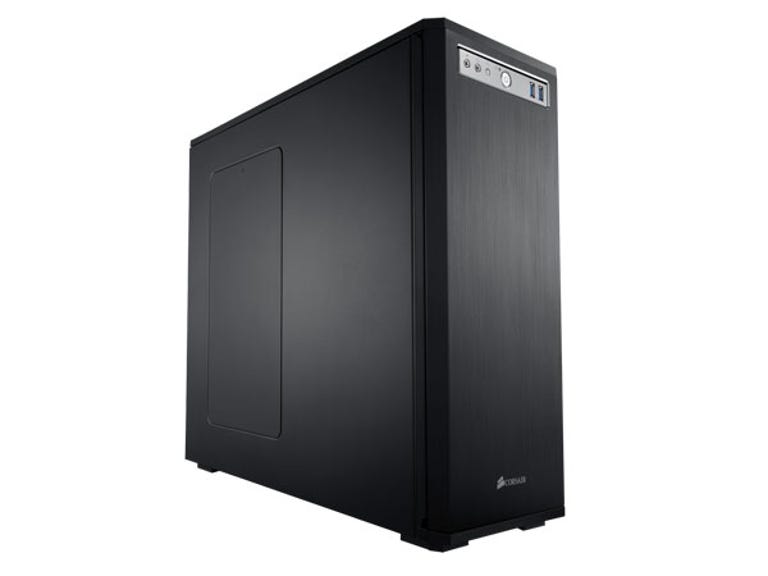 Why You Can Trust CNET
Why You Can Trust CNET Corsair Obsidian 550D review: Corsair Obsidian 550D
It's clear that a lot of thought went in to the Obsidian 550D. If your ultimate goal is quietness and you can get away with a mid-tower, definitely give this one a look.
While we all wait for the successor to the 800D to turn up, Corsair's outed a smaller, more budget friendly version of its Obsidian line: the mid-tower beast designed to keep sound down.
The Good
The Bad
The Bottom Line
Despite being the junior in the Obsidian family, this thing is still built incredibly well, with its mostly steel construction; the rubberised, coarse plastic on top that prevents fingerprints; and the aluminium door on the front.
There are two things likely to be contentious on the 550D, and the door is one of them. You can remove it completely if you're not the door type, but the case does lose some of its aesthetic appeal once you do. It is, at least, designed to be opened either way, although often, we found ourselves pulling the whole door off by accident instead of swinging it in the intended direction.
Aside from the sound dampening material on the inside of the door, Corsair's been a little thoughtful in that it's included replacement parts for the door clips, just in case you happen to wear yours out through use.

The door can swing both ways, or be removed entirely. There's sound dampening material on pretty much every panel.
(Credit: Craig Simms)
The second contentious bit is the silver plastic strip that hosts the power and reset buttons, along with two USB 3.0 ports and headphone and microphone jacks. It looks worse in the pictures — in real life, the effect is nowhere near as jarring. But rather than provide an accent, it really does fly in the face of Corsair's typically premium look.
We've seen some people take exception to the silver strip on top. It's not as bad as the pictures make out, but it is jarring on an otherwise seamless aesthetic.
(Credit: Craig Simms)
There are some wonderful innovations here — both the side and the top panels have removable, sound dampened sections that, once removed by pushing down and releasing a magnetic clasp, reveal fan mounts. This isn't the clever bit — that would be the dust filters on top, which are held down by magnetic strips, making the filters not only tool-less, but very easy to install and remove.
Yet another "why hasn't someone done this before" innovation from Corsair: magnetic strips to hold dust filters in place.
(Credit: Craig Simms)
The top panel can host dual 120mm or 140mm fans, while the side can take dual 120mm, dual 140mm or a single 200mm fan. Pop open the sound-proofed side, and you'll find a 120mm extraction fan at the back (which can be replaced by a 140mm) and two 120mm fans at the front. Just like the top and side panel, at the front, you'll find a magnetically latched panel under which is a dust filter that is held in place by magnetic strips. A final 120mm/140mm mount can be found on the bottom of the case, in front of where the PSU would go, and this, along with air holes for under the PSU, is covered by a slide-out dust filter.
The side accepts a variety of fan options.
(Credit: Craig Simms)
The push-button release for the side panels is lovely to use.
(Credit: Craig Simms)
To the side of the eight expansion slots, you'll find four 20mm water cooling holes, while on the motherboard tray, Corsair's usual cable management holes and grommets are in place. Where the motherboard sits itself has been indented, which has the effect of creating a very definite channel for cables to run along the back. There's around 25mm to work with between tray and board, except where the indent is, which reduces this to around 10mm.
The rear of the motherboard tray, with indented mounting panel.
(Credit: Craig Simms)
Holy slots, Batman!
(Credit: Craig Simms)
Six removable 3.5-inch bays are mounted at the front, the flexible drive caddy in each able to mount 2.5-inch drives as well. Above these are four 5.25-inch drive bays, with each including a quick-remove system. It's easy enough to use, but if you don't hold truck with such things, it can be removed, allowing you to use normal screws instead.
Corsair's flexible drive bays make the Obsidian 550D a potential water-cooling target.
(Credit: Craig Simms)
The soft rubber feet are a nice touch — ensuring that nothing will get scratched, even when dragging the case about. While Corsair includes the usual accessories, it does also include a USB 3.0 to 2.0 adapter for the front ports.
It's clear that a lot of thought went in to the Obsidian 550D — Corsair seems intent on bringing at least one new feature to each of its cases, which make you wonder why anyone hadn't done it before. If your ultimate goal is quietness and you can get away with a mid-tower, definitely give this one a look.


